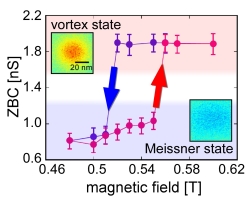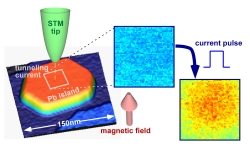Vortex Excitation in Nano-Size Superconductors by Local Current Injection
Hasegawa Group
When a type-II superconductor is subjected to an external magnetic field whose amount is larger than the lower critical field, superconductivity is locally broken and quantized amount magnetic fluxes, or vortices, penetrate through it. In the case of nano-size superconductors, however, because of the Bean-Livingston (BL) barrier existing at their periphery, vortices cannot get in even above the critical field despite a fact that being inside is energetically favorable. Here, we demonstrate that in such "superheated" situation, a vortex can be excited into the superconductor via lowering of the barrier by a local tunneling current injected from a probe tip of a scanning tunneling microscope [1].

Fig.1. Zero bias conductance as a function of applied magnetic field measured at the center of a Pb island, whose STM image is shown in Fig. 2. High (low) ZBC indicates the vortex (Meissner) states of the nano-size superconductor. Insets are ZBC images showing high (red) / low (blue) ZBC values for the corresponding two states.

Fig.2. Excitation of a single vortex by a pulsed current injection from an STM tip. ZBC images taken before and after the current injection indicate the vortex penetration by the pulse.
As a nano-size type-II superconductor, we used a Pb island structure whose thickness is ~3 nm formed on a silicon substrate. The size of the islands is ~ 100 nm, several times larger than its coherent length (31 nm at the measurement temperature (2 K)). Tunneling conductance at zero bias voltage (zero bias conductance; ZBC), that is, conductance at the bottom of a superconducting gap, provides us information on whether superconductivity below the tip is broken or not and whether a vortex is inside the superconductor or not [2]. A profile of ZBC as a function of applied magnetic field measured at the center of the island, shown in Fig. 1, exhibits a hysteresis between the vortex and Meissner (non-vortex) states, which is explained by the existence of the BL barrier. Insets in Fig. 1 are ZBC images showing high (red) / low (blue) ZBC values for the corresponding two states. A red vortex is clearly observed in the vortex state ZBC image.
We applied the magnetic field (0.55 T) just below the vortex penetration field, at which ZBC jumps up, while keeping the Meissner state in order to make a metastable ("superheated") state. Then pulsed tunneling current was injected from the STM tip. ZBC images taken before and after the current injection clearly indicate vortex penetration into the Pb island during the pulse application (Fig. 2).
Repeated experiments under various conditions revealed that successful excitation needs large pulsed current (> 400 pA) and long pulse duration (> 200 ms). It is also found that current injection at peripheral sites is more preferable for the excitation than around the center of the islands. Based on calculations using a time-dependent Ginzburg-Landau equation, we conclude that the vortex excitation is induced by the formation of normal conducting area below the tip; superconductivity is locally broken first by the current exceeding the critical current density, and then once broken area is nucleated finite resistance in the area generates the Joule heat to expand the normal area. When the broken area grows large enough to lower the BL barrier, a vortex penetrates into the island. The theoretical analyses of the penetration magnetic field and its dependences on the size and site of the normal area support our experimental observations.
References
- T. Nishio, S. Lin, T. An, T. Eguchi1 and Y. Hasegawa, Nanotechnology 21, 465704 (2010).
- T. Nishio, T. An, A. Nomura, K. Miyachi, T. Eguchi, H. Sakata, S. Lin, N. Hayashi, N. Nakai, M. Machida, and Y. Hasegawa, Phys. Rev. Lett. 101, 167001 (2008).
